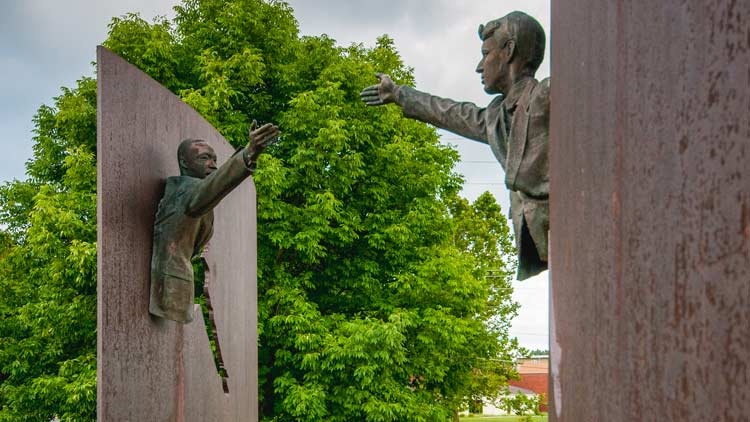The Kennedy-King National Commemorative Site stands at 17th and Broadway where, on April 4, 1968, Robert F. Kennedy (RFK) made his famous speech announcing that Dr. Martin Luther King Jr. (MLK) had been assassinated (see ).
Kennedy, who had traveled to Indianapolis that day for a rally to promote his presidential campaign, was advised to cancel the rally. Local civic leaders feared that riots would break out as they had in other cities in reaction to the killing. Instead, the presidential candidate proceeded as scheduled to the urban park at 17th and Broadway at the heart of a predominately Black neighborhood.
Most of the rally’s approximately 2,500 attendees had not heard of King’s death at the time of Kennedy’s arrival to the park. His words from that night are often credited with keeping Indianapolis calm amidst violence in other parts of the country following King’s death.
Two months after the rally, Robert F. Kennedy was assassinated at the Ambassador Hotel in Los Angeles, California. A portion of his speech from April 4th is inscribed on a memorial wall adjoining his gravesite at Arlington National Cemetery, which was dedicated in December 1971.

A couple of decades later, civic leaders in Indianapolis worked together to create their own memorial honoring Kennedy and King at the park where the former made his speech, which had since been renamed Martin Luther King Jr. Park to commemorate the occasion. The idea was originally suggested by Mel Simon And Associates (later ) executive during a conversation with local art critic and professor Steve Mannheimer.
When Conrad died in 1990, no plans had been made regarding the design or construction of an actual memorial. Four years later, however, Mannheimer shared Conrad’s idea with Donnie Walsh, then-President and CEO of the as well as the founder of the recently formed Pacers Foundation (both organizations are connected to the Simon family, which also oversees Simon Property Group). Walsh liked the idea and decided it would serve as one of the foundation’s first projects.
A national design competition for a Kennedy-King memorial was funded by the foundation and overseen by Mannheimer and Pacers executive Kathryn Jordan. Out of 50 submissions, the jury selected the proposal by Indiana-born artist and writer Greg R. Perry. His design featured two half-figures—one of King, the other of Kennedy—reaching their hands out to one another over a walkway. This concept captured the spirit of both leaders’ commitment to peace and reconciliation. As part of the memorial project, the Indianapolis agreed to oversee the redesign of the southern half of Martin Luther King Jr. Park where the sculpture would stand.
On May 14, 1994, a groundbreaking ceremony for the monument was held. Several well-known dignitaries attended this event, including RFK’s widow Ethel Kennedy; two of MLK Jr.’s sons, Dexter Scott King and Martin Luther King III; Senator Ted Kennedy (RFK’s younger brother), and President Bill Clinton.
Following the ceremony, Perry’s design was sculpted and cast in bronze and Cor-Ten steel by Indiana-born artist Daniel Edwards. A marker with a bronze plaque was also installed on either side of the monument. One of these markers lists the names of the memorial’s financial, creative, and/or community contributors, while the other includes the full text of Kennedy’s April 4th speech. A third marker near the actual spot where RFK spoke contains the remnants of guns confiscated by the Indianapolis police or collected as part of a city amnesty program created in conjunction with the Indiana Pacers. It represents a community-based effort to stop violence in the city.
The unveiling of the Landmark for Peace memorial occurred on September 30, 1995. President Clinton returned to Indianapolis to dedicate the monument.
In the years since this dedication, the memorial has served as the site of several programs and events. Many of these activities are organized by the Kennedy King Memorial Initiative (KKMI), a nonprofit organization established in 2015. KKMI’s mission is to build on the historical events of April 4, 1968, to raise awareness, provoke thought, and inspire action to eliminate division and injustice.
On April 4, 2018, KKMI held a commemorative ceremony at the Landmark for Peace in recognition of the 50th anniversary of Kennedy’s speech. Remarks and remembrances were made by several state and national leaders, including Indianapolis Mayor Joe Hogsett, Indiana Governor Eric Holcomb, Congressman Andre Carson, Congressman and civil rights leader John Lewis, and RFK’s daughter Kerry Kennedy.
That same day, the Landmark for Peace memorial was designated as the Kennedy-King National Commemorative Site by President Donald Trump.

Help improve this entry
Contribute information, offer corrections, suggest images.
You can also recommend new entries related to this topic.

